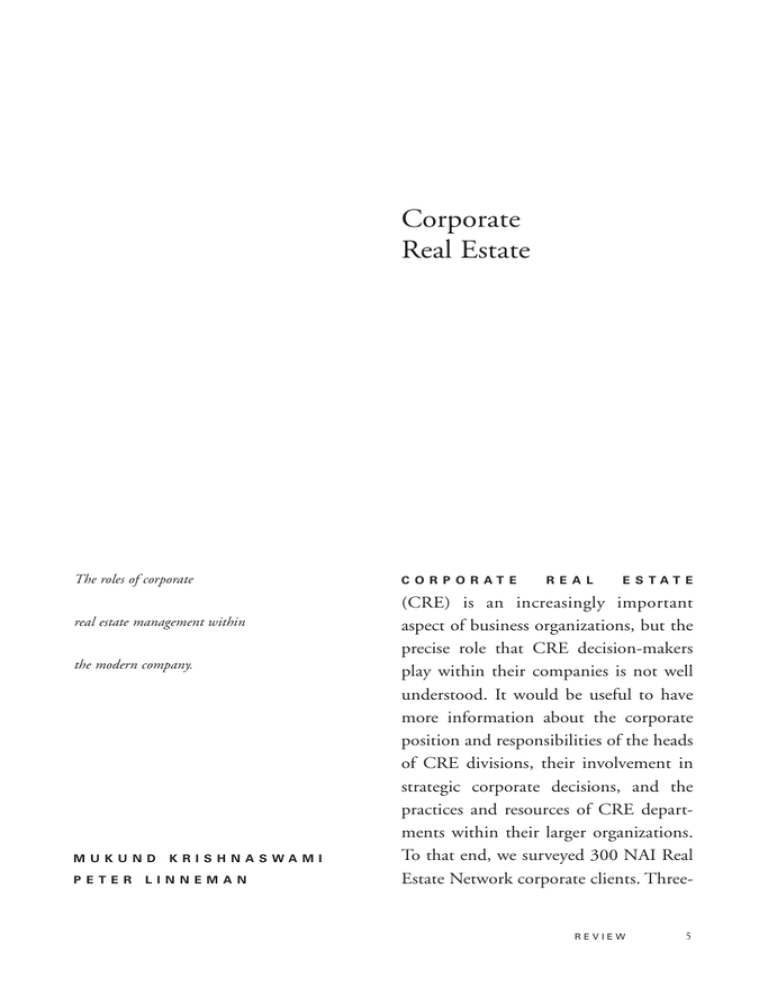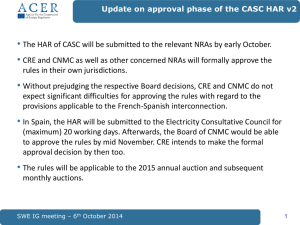Corporate Real Estate
advertisement

Corporate Real Estate The roles of corporate real estate management within the modern company. MUKUND PETER KRISHNASWAMI LINNEMAN C O R P O R AT E R E A L E S TAT E (CRE) is an increasingly important aspect of business organizations, but the precise role that CRE decision-makers play within their companies is not well understood. It would be useful to have more information about the corporate position and responsibilities of the heads of CRE divisions, their involvement in strategic corporate decisions, and the practices and resources of CRE departments within their larger organizations. To that end, we surveyed 300 NAI Real Estate Network corporate clients. Three- REVIEW 5 Figure 1: Primary Industry of Respondents 5% 7% 12% 26% Mining, Utilities, Construction Manufacturing Wholesale and Retail Trade 24% Finance, Insurance, and Real Estate Other Services Other 26% quarters of the 78 responding companies are publicly owned, with the manufacturing, wholesale/retail trade and FIRE (finance, insurance and real estate) sectors each representing about a quarter of the respondents (Figure 1). The respondents are generally large firms, with 84 percent generating revenues in excess of $1 billion per year, while only one respondent has annual revenues of less than $100 million. Although all the firms are headquartered in the United States, 50 percent are “global” firms, while 35 percent are “national,” and 9 percent are “regional.” These firms have substantial corporate real estate holdings, with the most widely held asset being office space (Figure 2). Figure 2: Breakdown of CRE Ownership (in footage) 2% 15% Office space Warehouse/Distribution 40% R&D Retail Industrial/Manufacturing Land 27% 3% 6 ZELL/LURIE 13% REAL ESTATE CENTER CRE O R G A N I Z AT I O N The limited role that CRE heads play in corporate policy is underscored by the fact that only 9 percent hold the rank of Executive Vice President/Managing Director (EVP/MD). More than half are Senior Vice Presidents/Directors (SVP/D), while about a quarter are Vice Presidents/ Managers (VP/M). The lack of a “strategic” role for CRE is demonstrated by the fact that two-thirds of CRE heads report to administration, engineering and operations, planning, or purchasing, and a only a third report to finance (Figure 3). Thus, in spite of the fact that corporate real estate is the largest balance sheet item for most of these firms, the CRE department is generally viewed as functional rather than financial. Somewhat surprisingly, CRE heads in the EVP/MD category disproportionately report to administration, while SVP/Dlevel executives disproportionately report to finance. This suggests that even in firms where CRE is considered important enough to merit a senior executive head, the group is largely seen as “task” oriented. The CRE reporting relationship also varies between public and private firms, with CRE heads in private firms disproportionately reporting to administration, while those in public companies disproportionately report to finance. This suggests that public companies see their companies as financial entities to be scrutinized for return on equity. Staff sizes vary. Only 9 percent of the respondents have a staff greater than 100, Figure 3: Percent of CRE Heads Reporting to Each Department, by Title of CRE Head 80% 70% 60% 50% 40% 30% 20% 10% 0% Finance/Treasury All EVP/MD Administrative SVP/Director VP/Manager Other Other REVIEW 7 Figure 4: Corporate Real Estate Staff Size 9% 8% 27% 1 to 3 4 to 10 11 to 20 19% 21 to 50 51 to 100 More than 100 32% 5% while more than half have a staff fewer than ten employees (Figure 4). This indicates that most firms engage in substantial outsourcing of their real estate activities. The respondents report varying degrees of outsourcing activity. Sixty percent of respondents outsource less than a quarter of their activity, while 22 percent outsource more than half of all functions. The most commonly outsourced function is property management, followed by dispositions. None of the respondents outsource their finance function, demonstrating that this “control” element of CRE is a core Figure 5: Distribution of CRE Staff Size by Reporting Department 60% 50% 40% 30% 20% 10% 0% Finance/Treasury < 10 8 11 to 50 ZELL/LURIE REAL Administrative > 50 ESTATE CENTER Other Distribution of CRE Staff Size by Title of CRE Head 70% 60% 50% 40% 30% 20% 10% 0% EVP/MD < 10 SVP/Director 11 to 50 VP/Manager Other > 50 function for all CRE groups. Eleven percent of the respondents selected outsourced suppliers on a market-by-market basis, while 29 percent selected best in class suppliers in the local market. Thirtytwo percent of the respondents have entered into long-term agreements with best-in-class suppliers, and 28 percent have multi-year agreements at a portfolio level. There is a relationship between the title of the CRE head and staff size (Figure 5). For example, the Executive VP group has Figure 6: Distribution of Staff Type by Title of CRE Head 70% 60% 50% 40% 30% 20% 10% 0% Part time All EVP/MD Full time SVP/Director Full time/Some experts VP/Manager All experts Other REVIEW 9 Figure 7: Distribution of Budget Type by Title of CRE Head 50% 45% 40% 35% 30% 25% 20% 15% 10% 5% 0% Budget in Different Dept. All EVP/MD Budget Authority Without Travel SVP/Director disproportionately large staffs, reflecting the larger managerial role required by larger, in-house departments. Also, those CRE departments with a staff size in excess of 100 employees represent three-quarters of respondents who report to finance/treasury or administration. CRE departments consist of both full- and part-time employees, with a positive relationship between the seniority of the head of CRE and their use of full-time staff (Figure 6). Only 6 percent of respondents have department budgets contained in another department, and only 10 percent have limited budget authority (Figure 7). Thus, although “task” oriented by structure, most CREs are provided with budgeting capacity, which means that a key part of their job is to prioritize competing 10 ZELL/LURIE REAL ESTATE CENTER Budget Authority With Travel/Consultants VP/Manager Budget For All Other corporate real estate demands across operating divisions. ROLE WITHIN O R G A N I Z AT I O N S Respondents were asked to rank the involvement of CRE in their organization for several functions, including strategy, transaction, processing/administration, dispositions, and due diligence (Table I). Amazingly, nearly every function has a median response of 1 (the lowest possible involvement level), with the exception of transactional involvement, which has median rating of 6.5 out of 10. This “task” orientation of CRE is further highlighted by the high average importance rank of Table I: Involvement of CRE, by Function Strategic Consultative Transactional Process/ Admin Dispositions Due Diligence Median 1.0 1.0 6.5 1.5 1.0 0.5 Mean 2.8 2.9 5.0 3.5 3.7 3.1 Transactional Process/ Admin Table II: Mean Values for Each Title Strategic MD/EVP Consultative Dispositions Due Diligence 1.1 1.1 2.3 1.6 2.1 1.1 SVP/Director 2.6 2.7 5.3 3.5 3.7 3.5 VP/Manager 4.0 4.1 5.5 4.1 4.0 3.3 Other 1.8 4.2 2.6 3.8 0.8 1.8 transactions, dispositions and process/ administration. The lack of strategic involvement is clear from the low ratings for strategic and consultative involvement. The “task” role of CRE is highlighted by the fact that while 94 percent of respondents play a role in their corporate mergers and acquisitions (M&A) process, only 23 percent are involved from the beginning (that is, from the planning stage); 48 percent are only brought in for due diligence, 14 percent Figure 8: Percent of Respondents Reporting Initial Involvement in Various M&A Stages, by Title of CRE Head 70% 60% 50% 40% 30% 20% 10% 0% Planning All Due Diligence EVP/MD SVP/Director Integration VP/Manager Post Integration No Role Other REVIEW 11 Percent of Respondents Reporting Initial Involvement in Various M&A Stages, by Reporting Department 70% 60% 50% 40% 30% 20% 10% 0% Planning All Due Diligence EVP/MD Integration SVP/Director VP/Manager Post Integration No Role Other start with integration, and 8 percent start There is a positive relationship between only post-integration (Figure 8). Thus, the title of the CRE head and the nature of even though property leases and mort- department objectives (Figure 9). Over 70 gages are a substantial element in most percent of the Executive VPs, and 45 permergers, CRE involvement generally cent of Senior VPs, develop department 60% occurs only after the decision to merge has objectives either jointly or with the input of 50% made, and frequently only after the been clients. Yet amazingly, only 49 percent of deal is done. Not surprisingly, CRE heads the CRE group set annual department 40% at the Executive VP level are dispropor- objectives. Thus, while they may control tionately involved in planning stages. In their budget, many CRE groups are merely 30% contrast, 40 percent of the “Other” group divisional functionaries. Similarly, only half 20% no role in the M&A process. From a have either have full operating cost information reporting perspective, we found a signifi- for their global portfolio, or have such a sys10% cant relationship between the department tem under development. More than a third to0%which the head of CRE reports and have such information for U.S. properties Planning Due Diligence Integration Post Integration No Role their role in M&A, with those reporting only. Fifteen percent have incomplete inforAll Finance/Treasury Administrative Other to finance and administration having the mation even for the U.S. portfolio. This greatest degree of M&A involvement. widespread lack of basic information on the 12 ZELL/LURIE REAL ESTATE CENTER largest balance sheet item for major firms in an era of sophisticated reporting is shocking, and remains an area demanding substantial improvement. Private and smaller companies tend to have much less complete information about their real estate holdings than their public counterparts (Figure 10), with almost 75 percent of private companies having incomplete portfolio information, versus 44 percent of public firms. Thus, the greater public market scrutiny of assets Figure 9: Distribution of Property Responsibility Level by CRE Title Head 60% 50% 40% 30% 20% 10% 0% Some Involvement All Involvement in Most EVP/MD SVP/Director Advice/Counsel in Most VP/Manager Advice/Counsel in All Other Distribution of Property Responsibility Level by Reporting Department 60% 50% 40% 30% 20% 10% 0% Some Involvement All Involvement in Most Finance/Treasury Administrative Advice/Counsel in Most Advice/Counsel in All Other REVIEW 13 Figure 10: Breakdown of Public Company Responses Regarding CRE Information 13% 31% Incomplete Info Database of U.S. Costs U.S. Costs / Intl. Costs Under Development 31% Database of Global Costs 25% Breakdown of Private Company Responses Regarding CRE Information 11% 21% Incomplete Info 16% Database of U.S. Costs U.S. Costs / Intl. Costs Under Development Database of Global Costs 52% seems to generate more comprehensive asset management systems. We found a modest relationship between corporate officer status and the quality of information. The corporate title group with the highest percentage of incomplete cost information is the “Other” group, reflecting their “wilderness” status at these firms. In contrast, a third of Executive VPs have a database of global costs, which is nearly 10 percent above the average of all groups. 14 ZELL/LURIE REAL ESTATE CENTER From a reporting perspective, a significantly higher percentage of finance/treasury reports (28 percent) and administration reports (25 percent) have a database of global costs, versus only 11 percent of “Other” reports. Thus, where real estate is viewed as more of a strategic asset, the asset management is far superior. We also found a modest relationship between executive title and the sophistication of property information (Figure 11). Sixty percent of all Executive VP led CRE departments have complete databases of information shared with clients, versus only 21 percent of all respondents (Figure 12). By contrast, 60 percent of the “Other” title group have only basic information, versus 24 percent of all respondents. Once again, where real estate is viewed as a strategic asset, steps have been taken to properly manage the assets. However, where it is merely transactional in nature, the information is one-off in nature. Figure 11: Distribution of Level of Operating Cost Information, by Title of CRE Head 45% 40% 35% 30% 25% 20% 15% 10% 5% 0% Incomplete Info All Database of U.S. Costs EVP/MD SVP/Director U.S. Costs / Intl. Costs Database of Global Costs Under Development VP/Manager Other Distribution of Level of Operating Cost Information, by Reporting Department 50% 45% 40% 35% 30% 25% 20% 15% 10% 5% 0% Incomplete Info All Database of U.S. Costs U.S. Costs / Intl. Costs Database of Global Costs Under Development Finance/Treasury Administrative Other REVIEW 15 Figure 12: Distribution of Property Information, by Title of CRE Head 80% 70% 60% 50% 40% 30% 20% 10% 0% No Info System All Basic Info Database EVP/MD SVP/Director Complete Database Complete Database Shared With Clients VP/Manager Other Distribution of Property Information, by Reporting Department 70% 60% 50% 40% 30% 20% 10% 0% No Info System All Basic Info Database Finance/Treasury Administrative The key role of transactions for CRE is demonstrated by a third of respondents having well-documented means of completing transactions globally, and welldefined means domestically. Two-thirds of respondents “regularly” analyze portfolio or market trends. Eighteen percent report 16 ZELL/LURIE REAL ESTATE Complete Database CENTER Complete Database Shared With Clients Other do so “occasionally.” A staggering 16 percent “never” complete an annual real estate portfolio review. While 20 percent of our respondents have few department metrics, 38 percent have a “dashboard” of balanced scorecard metrics charted at least monthly. All of which underscore Figure 13: Distribution of Department Metrics, by Title of CRE Head 70% 60% 50% 40% 30% 20% 10% 0% Few Metrics All Some Metrics Periodically Metrics Consistently Applied And Measured SVP/Director VP/Manager EVP/MD Monthly Dashboard of Balanced Scorecard Other Distribution of Department Metrics, by Reporting Department 60% 50% 40% 30% 20% 10% 0% Few Metrics All Some Metrics Periodically Finance/Treasury Metrics Consistently Applied And Measured Administrative the most firms “task,” as opposed to “asset,” view of CRE. Eighty-five percent of Executive VPs, and 68 percent of Senior VPs, consistently apply metrics or a have a monthly dashboard of information (Figure 13). Only 40 percent of the “Other” group Monthly Dashboard of Balanced Scorecard Other (the corporate wilderness inhabitants) have that level of metrics. Sadly, as much as 23 percent of finance/treasury reports have “few metrics.” However, the percent of “Other” having a monthly dashboard is even worse. There is no significant relationship between title group and supplier REVIEW 17 management. The lowest title group (“Other”) holds the highest percentage of both the lowest and highest categories (per property suppliers and portfolio of key providers). Once again we see the “task” orientation of CRE. CONCLUSION Corporate real estate management, while becoming more sophisticated, remains generally a corporate backwater. The real challenge for CRE officers is to become strategic “creators of value,” rather than just “transactionalists” or “procurers.” Our survey suggests that organizations have varying degrees of CRE sophistication. Some companies place greater emphasis on the real estate function, as indicated by the importance given to the head of the CRE department, and the reporting relationship between the CRE department and the rest of the organization. In general, organizations giving more importance to CRE reported that CRE plays a more central role in decision-making, is better staffed and equipped, has clearer objectives, and has a more focused and effective approach to management at both an asset level and property management level. We believe that this will ultimately have a positive impact on these organizations. 18 ZELL/LURIE REAL ESTATE CENTER




